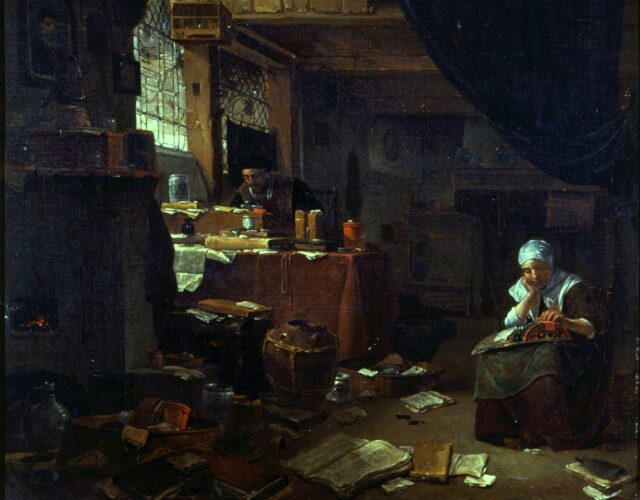Sometimes when I’m looking at an old family photo, I find myself trying to place a memory. “Is that our old apartment?” I might wonder to myself. My haircut can’t help pinpoint the year: I had bangs from age three until, uh, basically forever. So I look at clothes, furniture, holiday decorations, posters—anything that can help locate the picture in time. Almost everyone has looked at an old photo and said, “Who is that in the background?” or “What park did we have that picnic at?”
Art historians work with some of the same questions: “Whose portrait is this?” “When was this painted?” For answers, we might turn to conservation science (which can help date wooden panels through dendrochronology or identify period pigments by x-ray fluorescence scanning). We might read through artists’ biographies or art criticism. But we can also turn to architecture, fashion, and household goods.
Take a look at the scene above by the Dutch painter Thomas Wijck, The Alchemist in His Study with a Woman Making Lace from CHF’s collections. At right, a woman—probably the alchemist’s wife—sits bent over her embroidery pillow. Over her shoulders, she’s wearing what looks like a white cloth collar, perhaps trimmed with lace. A similar type of collar can be found in pictures by Johannes Vermeer, whom we know painted the majority of his works between 1650 and 1675.
Other details might catch our attention, such as the alchemist’s tabletop writing desk. Writing desks like these show up in other paintings, such as this portrait by Rembrandt, dated to around 1630. The tall blue and white jar sitting by the window also has a distinctive look. A little research into historical pottery and ceramics tells us that this jar looks like the medicine jars being produced in the Dutch city of Delft during the mid-17th century. Once again, the pieces start to come together!
It’s an art historian’s job to look closely. We look at lots of images and objects, and we do so very carefully. We look for patterns and connections. By examining people’s personal surroundings—the style of their clothes, the tools they use, and the everyday objects in their environment—we can learn more about the world they inhabit. When that world is a painting, it reveals another layer of information about the artist who crafted it. Whether it’s a family photo or a 17th-century painting, close looking is a powerful lens into the past.




